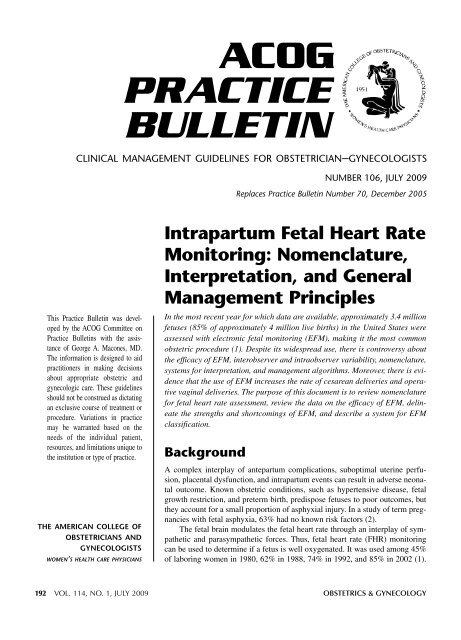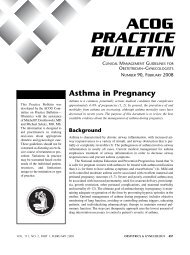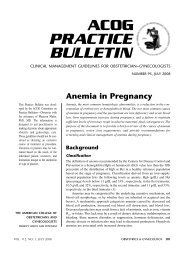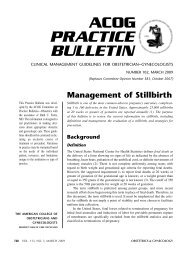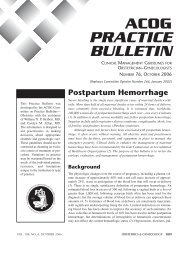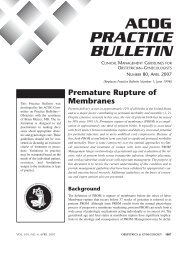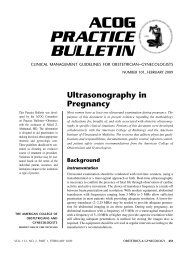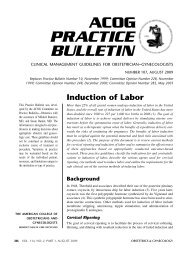ACOG Practice Bulletin: Intrapartum Fetal Heart rate Monitoring
ACOG Practice Bulletin: Intrapartum Fetal Heart rate Monitoring
ACOG Practice Bulletin: Intrapartum Fetal Heart rate Monitoring
- No tags were found...
Create successful ePaper yourself
Turn your PDF publications into a flip-book with our unique Google optimized e-Paper software.
<strong>ACOG</strong>PRACTICEBULLETINCLINICAL MANAGEMENT GUIDELINES FOR OBSTETRICIAN–GYNECOLOGISTSNUMBER 106, JULY 2009Replaces <strong>Practice</strong> <strong>Bulletin</strong> Number 70, December 2005This <strong>Practice</strong> <strong>Bulletin</strong> was developedby the <strong>ACOG</strong> Committee on<strong>Practice</strong> <strong>Bulletin</strong>s with the assistanceof George A. Macones, MD.The information is designed to aidpractitioners in making decisionsabout appropriate obstetric andgynecologic care. These guidelinesshould not be construed as dictatingan exclusive course of treatment orprocedure. Variations in practicemay be warranted based on theneeds of the individual patient,resources, and limitations unique tothe institution or type of practice.THE AMERICAN COLLEGE OFOBSTETRICIANS ANDGYNECOLOGISTSWOMEN’S HEALTH CARE PHYSICIANS<strong>Intrapartum</strong> <strong>Fetal</strong> <strong>Heart</strong> Rate<strong>Monitoring</strong>: Nomenclature,Interpretation, and GeneralManagement PrinciplesIn the most recent year for which data are available, approximately 3.4 millionfetuses (85% of approximately 4 million live births) in the United States wereassessed with electronic fetal monitoring (EFM), making it the most commonobstetric procedure (1). Despite its widespread use, there is controversy aboutthe efficacy of EFM, interobserver and intraobserver variability, nomenclature,systems for interpretation, and management algorithms. Moreover, there is evidencethat the use of EFM increases the <strong>rate</strong> of cesarean deliveries and operativevaginal deliveries. The purpose of this document is to review nomenclaturefor fetal heart <strong>rate</strong> assessment, review the data on the efficacy of EFM, delineatethe strengths and shortcomings of EFM, and describe a system for EFMclassification.BackgroundA complex interplay of antepartum complications, suboptimal uterine perfusion,placental dysfunction, and intrapartum events can result in adverse neonataloutcome. Known obstetric conditions, such as hypertensive disease, fetalgrowth restriction, and preterm birth, predispose fetuses to poor outcomes, butthey account for a small proportion of asphyxial injury. In a study of term pregnancieswith fetal asphyxia, 63% had no known risk factors (2).The fetal brain modulates the fetal heart <strong>rate</strong> through an interplay of sympatheticand parasympathetic forces. Thus, fetal heart <strong>rate</strong> (FHR) monitoringcan be used to determine if a fetus is well oxygenated. It was used among 45%of laboring women in 1980, 62% in 1988, 74% in 1992, and 85% in 2002 (1).192 VOL. 114, NO. 1, JULY 2009 OBSTETRICS & GYNECOLOGY
Despite the frequency of its use, limitations of EFMinclude poor interobserver and intraobserver reliability,uncertain efficacy, and a high false-positive <strong>rate</strong>.<strong>Fetal</strong> heart <strong>rate</strong> monitoring may be performed externallyor internally. Most external monitors use a Dopplerdevice with computerized logic to interpret and count theDoppler signals. Internal FHR monitoring is accomplishedwith a fetal electrode, which is a spiral wireplaced directly on the fetal scalp or other presenting part.Guidelines for Nomenclature andInterpretation of Electronic <strong>Fetal</strong><strong>Heart</strong> Rate <strong>Monitoring</strong>In 2008, the Eunice Kennedy Shriver National Instituteof Child Health and Human Development partnered withthe American College of Obstetricians and Gynecologistsand the Society for Maternal–<strong>Fetal</strong> Medicine tosponsor a workshop focused on electronic FHR monitoring(3). This 2008 workshop gathered a diverse group ofinvestigators with expertise and interest in the field toaccomplish three goals: 1) to review and update the definitionsfor FHR pattern categorization from the priorworkshop; 2) to assess existing classification systems forinterpreting specific FHR patterns and make recommendationsabout a system for use in the United States; and3) to make recommendations for research priorities forEFM. A complete clinical understanding of EFM necessitatesdiscussion of uterine contractions, baseline FHR<strong>rate</strong> and variability, presence of accelerations, periodicor episodic decelerations, and the changes in these characteristicsover time. A number of assumptions and factorscommon to FHR interpretation in the United Statesare central to the proposed system of nomenclatureand interpretation (3). Two such assumptions are of particularimportance. First, the definitions are primarilydeveloped for visual interpretation of FHR patterns, butshould be adaptable to computerized systems of interpretation.Second, the definitions should be applied tointrapartum patterns, but also are applicable to antepartumobservations.Uterine contractions are quantified as the number ofcontractions present in a 10-minute window, averagedover a 30-minute period. Contraction frequency alone isa partial assessment of uterine activity. Other factorssuch as duration, intensity, and relaxation time betweencontractions are equally important in clinical practice.Listed as follows is terminology used to describeuterine activity:Normal: five contractions or less in 10 minutes,averaged over a 30-minute windowTachysystole: more than five contractions in 10 minutes,averaged over a 30-minute windowCharacteristics of uterine contractions• The terms hyperstimulation and hypercontractilityare not defined and should be abandoned.• Tachysystole should always be qualified as to thepresence or absence of associated FHR decelerations.• The term tachysystole applies to both spontaneousand stimulated labor. The clinical response to tachysystolemay differ depending on whether contractionsare spontaneous or stimulated.Table 1 provides EFM definitions and descriptionsbased on the 2008 National Institute of Child Health andHuman Development Working Group findings. Decelerationsare defined as recurrent if they occur with at leastone half of the contractions.Classification of <strong>Fetal</strong> <strong>Heart</strong>Rate TracingsA variety of systems for EFM interpretation have beenused in the United States and worldwide (4–6). Based oncareful review of the available options, a three-tieredsystem for the categorization of FHR patterns is recommended(see box). It is important to recognize that FHRtracing patterns provide information only on the currentacid–base status of the fetus. Categorization of the FHRtracing evaluates the fetus at that point in time; tracingpatterns can and will change. An FHR tracing may moveback and forth between the categories depending on theclinical situation and management st<strong>rate</strong>gies used.Category I FHR tracings are normal. Category I FHRtracings are strongly predictive of normal fetal acid–basestatus at the time of observation. Category I FHR tracingsmay be monitored in a routine manner, and no specificaction is required.Category II FHR tracings are indeterminate. CategoryII FHR tracings are not predictive of abnormal fetalacid–base status, yet presently there is not adequate evidenceto classify these as Category I or Category III.Category II FHR tracings require evaluation and continuedsurveillance and reevaluation, taking into accountthe entire associated clinical circumstances. In some circumstances,either ancillary tests to ensure fetal wellbeingor intrauterine resuscitative measures may be usedwith Category II tracings.Category III FHR tracings are abnormal. Category IIItracings are associated with abnormal fetal acid–basestatus at the time of observation. Category III FHR tracingsrequire prompt evaluation. Depending on the clinicalsituation, efforts to expeditiously resolve theVOL. 114, NO. 1, JULY 2009 <strong>ACOG</strong> <strong>Practice</strong> <strong>Bulletin</strong> <strong>Intrapartum</strong> <strong>Fetal</strong> <strong>Heart</strong> Rate <strong>Monitoring</strong> 193
Table 1. Electronic <strong>Fetal</strong> <strong>Monitoring</strong> DefinitionsPatternBaselineBaseline variabilityAccelerationEarly decelerationLate decelerationVariable decelerationProlonged decelerationSinusoidal patternDefinition• The mean FHR rounded to increments of 5 beats per minute during a 10-minute segment, excluding:—Periodic or episodic changes—Periods of marked FHR variability—Segments of baseline that differ by more than 25 beats per minute• The baseline must be for a minimum of 2 minutes in any 10-minute segment, or the baseline for that time periodis indeterminate. In this case, one may refer to the prior 10-minute window for determination of baseline.• Normal FHR baseline: 110–160 beats per minute• Tachycardia: FHR baseline is greater than 160 beats per minute• Bradycardia: FHR baseline is less than 110 beats per minute• Fluctuations in the baseline FHR that are irregular in amplitude and frequency• Variability is visually quantitated as the amplitude of peak-to-trough in beats per minute.—Absent—amplitude range undetectable—Minimal—amplitude range detectable but 5 beats per minute or fewer—Mode<strong>rate</strong> (normal)—amplitude range 6–25 beats per minute—Marked—amplitude range greater than 25 beats per minute• A visually apparent abrupt increase (onset to peak in less than 30 seconds) in the FHR• At 32 weeks of gestation and beyond, an acceleration has a peak of 15 beats per minute or more above baseline,with a duration of 15 seconds or more but less than 2 minutes from onset to return.• Before 32 weeks of gestation, an acceleration has a peak of 10 beats per minute or more above baseline, with aduration of 10 seconds or more but less than 2 minutes from onset to return.• Prolonged acceleration lasts 2 minutes or more but less than 10 minutes in duration.• If an acceleration lasts 10 minutes or longer, it is a baseline change.• Visually apparent usually symmetrical gradual decrease and return of the FHR associated with a uterine contraction• A gradual FHR decrease is defined as from the onset to the FHR nadir of 30 seconds or more.• The decrease in FHR is calculated from the onset to the nadir of the deceleration.• The nadir of the deceleration occurs at the same time as the peak of the contraction.• In most cases the onset, nadir, and recovery of the deceleration are coincident with the beginning, peak, andending of the contraction, respectively.• Visually apparent usually symmetrical gradual decrease and return of the FHR associated with a uterine contraction• A gradual FHR decrease is defined as from the onset to the FHR nadir of 30 seconds or more.• The decrease in FHR is calculated from the onset to the nadir of the deceleration.• The deceleration is delayed in timing, with the nadir of the deceleration occurring after the peak of the contraction.• In most cases, the onset, nadir, and recovery of the deceleration occur after the beginning, peak, and ending ofthe contraction, respectively.• Visually apparent abrupt decrease in FHR• An abrupt FHR decrease is defined as from the onset of the deceleration to the beginning of the FHR nadir of lessthan 30 seconds.• The decrease in FHR is calculated from the onset to the nadir of the deceleration.• The decrease in FHR is 15 beats per minute or greater, lasting 15 seconds or greater, and less than 2 minutes induration.• When variable decelerations are associated with uterine contractions, their onset, depth, and duration commonlyvary with successive uterine contractions.• Visually apparent decrease in the FHR below the baseline• Decrease in FHR from the baseline that is 15 beats per minute or more, lasting 2 minutes or more but less than 10minutes in duration.• If a deceleration lasts 10 minutes or longer, it is a baseline change.• Visually apparent, smooth, sine wave-like undulating pattern in FHR baseline with a cycle frequency of 3–5 perminute which persists for 20 minutes or more.Abbreviation: FHR, fetal heart <strong>rate</strong>.Macones GA, Hankins GD, Spong CY, Hauth J, Moore T. The 2008 National Institute of Child Health and Human Development workshop report on electronic fetal monitoring:update on definitions, interpretation, and research guidelines. Obstet Gynecol 2008;112:661–6.194 <strong>ACOG</strong> <strong>Practice</strong> <strong>Bulletin</strong> <strong>Intrapartum</strong> <strong>Fetal</strong> <strong>Heart</strong> Rate <strong>Monitoring</strong> OBSTETRICS & GYNECOLOGY
Three-Tiered <strong>Fetal</strong> <strong>Heart</strong> Rate Interpretation SystemCategory I• Category I FHR tracings include all of the following:• Baseline <strong>rate</strong>: 110–160 beats per minute• Baseline FHR variability: mode<strong>rate</strong>• Late or variable decelerations: absent• Early decelerations: present or absent• Accelerations: present or absentCategory IICategory II FHR tracings includes all FHR tracings notcategorized as Category I or Category III. Category IItracings may represent an appreciable fraction of thoseencountered in clinical care. Examples of Category IIFHR tracings include any of the following:Baseline <strong>rate</strong>• Bradycardia not accompanied by absent baselinevariability• TachycardiaBaseline FHR variability• Minimal baseline variability• Absent baseline variability with no recurrentdecelerations• Marked baseline variabilityAccelerations• Absence of induced accelerations after fetal stimulationPeriodic or episodic decelerations• Recurrent variable decelerations accompanied byminimal or mode<strong>rate</strong> baseline variability• Prolonged deceleration more than 2 minutes butless than10 minutes• Recurrent late decelerations with mode<strong>rate</strong> baselinevariability• Variable decelerations with other characteristics suchas slow return to baseline, overshoots, or “shoulders”Category IIICategory III FHR tracings include either• Absent baseline FHR variability and any of thefollowing:—Recurrent late decelerations—Recurrent variable decelerations—Bradycardia• Sinusoidal patternAbbreviation: FHR, fetal heart <strong>rate</strong>Macones GA, Hankins GD, Spong CY, Hauth J, Moore T. The 2008National Institute of Child Health and Human Development workshopreport on electronic fetal monitoring: update on definitions, interpretation,and research guidelines. Obstet Gynecol 2008;112:661–6.abnormal FHR pattern may include but are not limited toprovision of maternal oxygen, change in maternal position,discontinuation of labor stimulation, treatment ofmaternal hypotension, and treatment of tachysystolewith FHR changes. If a Category III tracing does notresolve with these measures, delivery should be undertaken.Guidelines for Review of Electronic<strong>Fetal</strong> <strong>Heart</strong> Rate <strong>Monitoring</strong>When EFM is used during labor, the nurses or physiciansshould review it frequently. In a patient without complications,the FHR tracing should be reviewed approximatelyevery 30 minutes in the first stage of labor andevery 15 minutes during the second stage. The correspondingfrequency for patients with complications (eg,fetal growth restriction, preeclampsia) is approximatelyevery 15 minutes in the first stage of labor and every 5minutes during the second stage. Health care providersshould periodically document that they have reviewedthe tracing. The FHR tracing, as part of the medicalrecord, should be labeled and available for review if theneed arises. Computer storage of the FHR tracing thatdoes not permit overwriting or revisions is reasonable, asis microfilm recording.Clinical Considerations andRecommendationsHow efficacious is intrapartum electronicfetal heart <strong>rate</strong> monitoring?The efficacy of EFM during labor is judged by its abilityto decrease complications, such as neonatal seizures,cerebral palsy, or intrapartum fetal death, while minimizingthe need for unnecessary obstetric interventions,such as operative vaginal delivery or cesarean delivery.There are no randomized clinical trials to compare thebenefits of EFM with any form of monitoring duringlabor (7). Thus, the benefits of EFM are gauged fromreports comparing it with intermittent auscultation.A meta-analysis synthesizing the results of the randomizedclinical trials comparing the modalities had thefollowing conclusions (8):• The use of EFM compared with intermittent auscultationincreased the overall cesarean delivery <strong>rate</strong>(relative risk [RR], 1.66; 95% confidence interval[CI], 1.30–2.13) and the cesarean delivery <strong>rate</strong> forabnormal FHR or acidosis or both (RR, 2.37; 95%CI, 1.88–3.00).VOL. 114, NO. 1, JULY 2009 <strong>ACOG</strong> <strong>Practice</strong> <strong>Bulletin</strong> <strong>Intrapartum</strong> <strong>Fetal</strong> <strong>Heart</strong> Rate <strong>Monitoring</strong> 195
• The use of EFM increased the risk of both vacuumand forceps operative vaginal delivery (RR, 1.16;95% CI, 1.01–1.32).• The use of EFM did not reduce perinatal mortality(RR, 0.85; 95% CI, 0.59–1.23).• The use of EFM reduced the risk of neonatal seizures(RR, 0.50; 95% CI, 0.31–0.80).• The use of EFM did not reduce the risk of cerebralpalsy (RR, 1.74; 95% CI, 0.97–3.11).There is an unrealistic expectation that a nonreassuringFHR tracing is predictive of cerebral palsy. Thepositive predictive value of a nonreassuring pattern topredict cerebral palsy among singleton newborns withbirth weights of 2,500 g or more is 0.14%, meaning thatout of 1,000 fetuses with a nonreassuring FHR pattern,only one or two will develop cerebral palsy (9). The falsepositive<strong>rate</strong> of EFM for predicting cerebral palsy isextremely high, at greater than 99%.Available data, although limited in quantity, suggestthat the use of EFM does not result in a reduction in cerebralpalsy (8). This is consistent with data that suggestthat the occurrence of cerebral palsy has been stable overtime, despite the widespread introduction of EFM (10).The principal explanation for why the prevalence ofcerebral palsy has not diminished despite the use of EFMis that 70% of cases occur before the onset of labor; only4% of cases of encephalopathy can be attributed solelyto intrapartum events (11, 12).Given that the available data do not show a clearbenefit for the use of EFM over intermittent auscultation,either option is acceptable in a patient without complications.Logistically, it may not be feasible to adhere toguidelines for how frequently the heart <strong>rate</strong> should beauscultated. One prospective study noted that the protocolfor intermittent auscultation was successfully completedin only 3% of the cases (13). The most commonreasons for unsuccessful intermittent auscultationincluded the frequency of recording and the requirementsfor recording.Intermittent auscultation may not be appropriate forall pregnancies. Most of the clinical trials that compareEFM with intermittent auscultation have excluded participantsat high risk of adverse outcomes, and the relativesafety of intermittent auscultation in such cases isuncertain. The labor of women with high-risk conditions(eg, suspected fetal growth restriction, preeclampsia, andtype 1 diabetes) should be monitored with continuousFHR monitoring.There are no comparative data indicating the optimalfrequency at which intermittent auscultation shouldbe performed in the absence of risk factors. One methodis to evaluate and record the FHR at least every 15 minutesin the active phase of the first stage of labor and atleast every 5 minutes in the second stage (14).What is the interobserver and intraobservervariability of intrapartum electronic fetalheart <strong>rate</strong> monitoring assessment?There is high interobserver and intraobserver variabilityin the interpretation of FHR tracings. For example, whenfour obstetricians examined 50 cardiotocograms, theyagreed in only 22% of the cases (15). Two months later,during the second review of the same 50 tracings, the cliniciansinterpreted 21% of the tracings differently thanthey did during the first evaluation. In another study, fiveobstetricians independently interpreted 150 cardiotocograms(16). The obstetricians interpreted the tracingssimilarly in 29% of the cases, suggesting poor interobserverreliability.The interpretation of cardiotocograms is more consistentwhen the tracing is normal (17). With retrospectivereviews, the foreknowledge of neonatal outcome mayalter the reviewer’s impressions of the tracing. Given thesame intrapartum tracing, a reviewer is more likely tofind evidence of fetal hypoxia and criticize the obstetrician’smanagement if the outcome was poor versus good(18). Therefore, reinterpretation of the FHR tracing,especially if neonatal outcome is known, may not bereliable.When should the very preterm fetus bemonitored?The decision to monitor the very preterm fetus requiresa discussion between the obstetrician, pediatrician, andpatient concerning the likelihood of survival or severemorbidity of the preterm child (based on gestational age,estimated fetal weight, and other factors) and issuesrelated to mode of delivery. If a patient undergoes acesarean delivery for indications related to a pretermfetus, continuous monitoring should be used rather thanintermittent auscultation. The earliest gestational agethat this will occur may vary.Nonreassuring FHR patterns may occur with up to60% of women with preterm labor, with the most commonabnormality being deceleration and bradycardia,followed by tachycardia and minimal or absent baselinevariability (19). Variable decelerations are more commonamong preterm (55–70%) deliveries than term(20–30%) deliveries (20). If FHR abnormalities are persistent,intrauterine resuscitation, ancillary tests toensure fetal well-being, and possibly delivery should beundertaken (21).196 <strong>ACOG</strong> <strong>Practice</strong> <strong>Bulletin</strong> <strong>Intrapartum</strong> <strong>Fetal</strong> <strong>Heart</strong> Rate <strong>Monitoring</strong> OBSTETRICS & GYNECOLOGY
What medications can affect the fetal heart<strong>rate</strong>?<strong>Fetal</strong> heart <strong>rate</strong> patterns can be influenced by the medicationsadministered in the intrapartum period. Mostoften, these changes are transient, although they sometimeslead to obstetric interventions.Epidural analgesia with local anesthetic agents (ie,lidocaine, bupivacaine) can lead to sympathetic blockade,maternal hypotension, transient uteroplacental insufficiency,and alterations in the FHR. Parenteral narcoticsalso may affect the FHR. A randomized trial comparingepidural anesthesia with 0.25% of bupivacaine and intravenousmeperidine reported that the variability wasdecreased, and FHR accelerations were significantly lesscommon with parenteral analgesia compared withregional analgesia (22). The <strong>rate</strong>s of decelerations andcesarean delivery for “nonreassuring” FHR tracingswere similar for the two groups. A systematic review offive randomized trials and seven observational studiesalso noted that the <strong>rate</strong> of cesarean delivery for nonreassuringFHR was similar between those who did andthose who did not receive epidural analgesia during labor(23).Concern has been raised about combined spinal–epidural anesthesia during labor. An intent-to-treatanalysis of 1,223 laboring women randomized to combinedspinal–epidural anesthesia (10 mcg of intrathecalsufentanil, followed by epidural bupivacaine and fentanylat the next request for analgesia) or intravenousmeperidine (50 mg on demand, maximum 200 mg in4 hours) noted a significantly higher <strong>rate</strong> of bradycardiaand emergent cesarean delivery for abnormal FHRin the group randomized to combined spinal–epiduralanesthesia (24). Neonatal outcome, however, was notsignificantly different between the two groups. Thereare some methodological concerns with this study.Another randomized controlled trial compared theoccurrence of FHR tracing abnormalities in laboringwomen who received combined spinal–epidural anesthesia(n= 41) to epidural anesthesia (n=46). In thisstudy, FHR abnormalities were more common inwomen receiving combined spinal–epidural anesthesia(25). Additional trials are necessary to determine thepotential safety and efficacy of the combined spinal–epidural technique.Other medications that influence FHR tracing havebeen studied (see Table 2). Of note, multiple regressionanalysis indicated that decreased variability attributed tothe use of magnesium sulfate was related to early gestationalage but not the serum magnesium level (26).Studies report different findings with regard to the effectof magnesium on FHR patterns. Some show no independenteffect; others show small changes in baseline orvariability. In general, however, caution should be usedin ascribing unfavorable findings on EFM to the use ofmagnesium alone.Transient sinusoidal FHR patterns occurred in 75%of patients who received butorphanol during labor, butthis was not associated with adverse outcomes (27).Fetuses exposed to cocaine did not exhibit any characteristicchanges in the heart <strong>rate</strong> pattern, although theydid have frequent contractions even when labor wasunstimulated (28). As determined by computer analysisof cardiotocograms, a randomized trial reported thatcompared with meperidine, nalbuphine used for intrapartumanalgesia decreased the likelihood of two 15-secondaccelerations over 20 minutes (29). In antepartumpatients, administration of morphine decreased not onlythe fetal breathing movement but also the number ofaccelerations (30).The effect of corticosteroids, which are used toenhance pulmonary maturity of fetuses during pretermlabor, on FHR has been studied (Table 2). Among twins(31) and singletons (32, 33), the use of betamethasonetransiently decreased the FHR variability, which returnedto pretreatment status by the fourth to seventh day. Therealso may be a decrease in the <strong>rate</strong> of accelerations withthe use of betamethasone. These changes, however, werenot associated with increased obstetric interventions orwith adverse outcomes (31). The biologic mechanism ofthis is unknown. Computerized analysis of the cardiotocogramsindicates that use of dexamethasone is not associatedwith a decrease in the FHR variability (33).What findings on EFM are consistent withnormal fetal acid–base status?The presence of FHR accelerations generally ensures thatthe fetus is not acidemic. The data relating FHR variabilityto clinical outcomes, however, are sparse. Results ofan observational study suggest that mode<strong>rate</strong> FHR variabilityis strongly associated with an arterial umbilicalcord pH higher than 7.15 (34). One study reported that inthe presence of late or variable decelerations, the umbilicalarterial pH was higher than 7.00 in 97% of the casesif the FHR tracing had normal variability (35). In anotherretrospective study, most cases of adverse neonatal outcomedemonst<strong>rate</strong>d normal FHR variability (36). Thisstudy is limited because it did not consider other characteristicsof the FHR tracing, such as the presence of accelerationsor decelerations. However, in most cases, normalFHR variability provides reassurance about fetal statusand the absence of metabolic acidemia.VOL. 114, NO. 1, JULY 2009 <strong>ACOG</strong> <strong>Practice</strong> <strong>Bulletin</strong> <strong>Intrapartum</strong> <strong>Fetal</strong> <strong>Heart</strong> Rate <strong>Monitoring</strong> 197
Table 2. Effects of Commonly Used Medications on <strong>Fetal</strong> <strong>Heart</strong> Rate PatternsMedications Comments ReferencesNarcotics At equivalent doses, all narcotics (with or without added antiemetics) have similar 1–7effects: a decrease in variability and a decrease in the frequency of accelerations75 mg meperidine = 10 mg morphine = 0.1 mg fentanyl = 10 mg nalbuphineButorphanol Transient sinusoidal FHR pattern, slight increased mean heart <strong>rate</strong> compared with meperidine 8, 9Cocaine Decreased long-term variability 10, 11Corticosteroids Decrease in FHR variability with beta-methasone but not dexamethasone, abolishment 12–15of diurnal fetal rhythms, increased effect at greater than 29 weeks of gestationMagnesium sulfate A significant decrease in short-term variability, clinically insignificant decrease in FHR, 16, 17inhibits the increase in accelerations with advancing gestational ageTerbutaline Increase in baseline FHR and incidence of fetal tachycardia 18, 19Zidovudine No difference in the FHR baseline, variability, number of accelerations, or decelerations 20Abbreviation: FHR, fetal heart <strong>rate</strong>.References1. Hill JB, Alexander JM, Sharma SK, McIntire DD, Leveno KJ. A comparison of the effects of epidural and meperidine analgesia during labor on fetal heart <strong>rate</strong>. ObstetGynecol 2003;102:333–7.2. Panayotopoulos N, Salamalekis E, Kassanos D, Vitoratos N, Loghis C, Batalias L. <strong>Intrapartum</strong> vibratory acoustic stimulation after maternal meperidine administration.Clin Exp Obstet Gynecol 1998;25:139–40.3. Zimmer EZ, Divon MY, Vadasz A. Influence of meperidine on fetal movements and heart <strong>rate</strong> beat-to-beat variability in the active phase of labor. Am J Perinatol1988;5:197–200.4. Kopecky EA, Ryan ML, Barrett JF, Seaward PG, Ryan G, Koren G, et al. <strong>Fetal</strong> response to maternally administered morphine. Am J Obstet Gynecol 2000;183:424–30.5. Rayburn W, Rathke A, Leuschen MP, Chleborad J, Weidner W. Fentanyl cit<strong>rate</strong> analgesia during labor. Am J Obstet Gynecol 1989;161:202–6.6. Nicolle E, Devillier P, Delanoy B, Durand C, Bessard G. Therapeutic monitoring of nalbuphine: transplacental transfer and estimated pharmacokinetics in theneonate. Eur J Clin Pharmacol 1996;49:485–9.7. Poehlmann S, Pinette M, Stubblefield P. Effect of labor analgesia with nalbuphine hydrochloride on fetal response to vibroacoustic stimulation. J Reprod Med1995;40:707–10.8. Hatjis CG, Meis PJ. Sinusoidal fetal heart <strong>rate</strong> pattern associated with butorphanol administration. Obstet Gynecol 1986;67:377–80.9. Quilligan EJ, Keegan KA, Donahue MJ. Double-blind comparison of intravenously injected butorphanol and meperidine in parturients. Int J Gynaecol Obstet1980;18:363–7.10. Chazotte C, Forman L, Gandhi J. <strong>Heart</strong> <strong>rate</strong> patterns in fetuses exposed to cocaine. Obstet Gynecol 1991;78:323–5.11. Tabor BL, Soffici AR, Smith-Wallace T, Yonekura ML. The effect of maternal cocaine use on the fetus: changes in antepartum fetal heart <strong>rate</strong> tracings. Am J ObstetGynecol 1991;165:1278–81.12. Senat MV, Minoui S, Multon O, Fernandez H, Frydman R, Ville Y. Effect of dexamethasone and betamethasone on fetal heart <strong>rate</strong> variability in preterm labour: arandomised study. Br J Obstet Gynaecol 1998;105:749–55.13. Rotmensch S, Liberati M, Vishne TH, Celentano C, Ben-Rafael Z, Bellati U. The effect of betamethasone and dexamethasone on fetal heart <strong>rate</strong> patterns and biophysicalactivities. A prospective randomized trial. Acta Obstet Gynecol Scand 1999;78:493–500.14. Koenen SV, Mulder EJ, Wijnberger LD, Visser GH. Transient loss of the diurnal rhythms of fetal movements, heart <strong>rate</strong>, and its variation after maternal betamethasoneadministration. Pediatr Res 2005;57:662–6.15. Mulder EJ, Koenen SV, Blom I, Visser GH. The effects of antenatal betamethasone administration on fetal heart <strong>rate</strong> and behaviour depend on gestational age. EarlyHum Dev 2004;76:65–77.16. Hallak M, Martinez-Poyer J, Kruger ML, Hassan S, Blackwell SC, Sorokin Y. The effect of magnesium sulfate on fetal heart <strong>rate</strong> parameters: a randomized, placebocontrolledtrial. Am J Obstet Gynecol 1999;181:1122–7.17. Wright JW, Ridgway LE, Wright BD, Covington DL, Bobitt JR. Effect of MgSO4 on heart <strong>rate</strong> monitoring in the preterm fetus. J Reprod Med 1996;41:605–8.18. Mawaldi L, Duminy P, Tamim H. Terbutaline versus nifedipine for prolongation of pregnancy in patients with preterm labor. Int J Gynaecol Obstet 2008;100:65–8.19. Roth AC, Milsom I, Forssman L, Ekman LG, Hedner T. Effects of intravenous terbutaline on maternal circulation and fetal heart activity. Acta Obstet Gynecol Scand1990;69:223–8.20. Blackwell SC, Sahai A, Hassan SS, Treadwell MC, Tomlinson MW, Jones TB, et al. Effects of intrapartum zidovudine therapy on fetal heart <strong>rate</strong> parameters in womenwith human immunodeficiency virus infection. <strong>Fetal</strong> Diagn Ther 2001;16:413–6.198 <strong>ACOG</strong> <strong>Practice</strong> <strong>Bulletin</strong> <strong>Intrapartum</strong> <strong>Fetal</strong> <strong>Heart</strong> Rate <strong>Monitoring</strong> OBSTETRICS & GYNECOLOGY
Are there ancillary tests that can aid in themanagement of Category II or Category IIIfetal heart <strong>rate</strong> tracings?There are some ancillary tests available that help toensure fetal well-being in the face of a Category II orCategory III FHR tracing, thereby reducing the highfalse-positive <strong>rate</strong> of EFM.In the case of an EFM tracing with minimal orabsent variability and without spontaneous acceleration,an effort should be made to elicit one. A meta-analysis of11 studies of intrapartum fetal stimulation noted thatfour techniques are available to stimulate the fetus: 1)fetal scalp sampling, 2) Allis clamp scalp stimulation,3) vibroacoustic stimulation, and 4) digital scalp stimulation(37). Because vibroacoustic stimulation and digitalscalp stimulation are less invasive than the other twomethods, they are the preferred methods. When there isan acceleration following stimulation, acidemia isunlikely and labor can continue.When a Category III FHR tracing is persistent, ascalp blood sample for the determination of pH or lactatemay be considered. However, the use of scalp pH assessmenthas decreased (38), and this test may not even beavailable at some tertiary hospitals (39). There are likelymany reasons for this decrease, including physicianexperience, difficulty in obtaining and processing anadequate sample in a short amount of time, and the needfor routine maintenance and calibration of laboratoryequipment that may be used infrequently. More importantly,scalp stimulation, which is less invasive, providessimilar information about the likelihood of fetalacidemia as does scalp pH.In one study, the sensitivity and positive predictivevalue of a low scalp pH (defined in the study as less than7.21 because it is the 75th percentile) to predict umbilicalarterial pH less than 7.00 was 36% and 9%, respectively(40). More importantly, the sensitivity and positivepredictive value of a low scalp pH to identify a newbornwith hypoxic–ischemic encephalopathy was 50% and3%, respectively. However, the greater utility of scalp pHis in its high negative predictive value (97–99%). Thereare some data to suggest that fetal scalp lactate levelshave higher sensitivity and specificity than scalp pH(40). However, a recent large randomized clinical trialthat compared the use of scalp pH assessment to scalplactate level assessment in cases of intrapartum fetaldistress did not demonst<strong>rate</strong> a difference in the <strong>rate</strong> ofacidemia at birth, Apgar scores, or neonatal intensivecare unit admissions (41). Although scalp stimulationhas largely replaced scalp pH and scalp lactate assessmentin the United States, if available, these tests mayprovide additional information in the setting of aCategory III tracing.Pulse oximetry has not been demonst<strong>rate</strong>d to be aclinically useful test in evaluating fetal status (42–44).Are there methods of intrauterine resuscitationthat can be used for Category II orCategory III tracings?A Category II or Category III FHR tracing requires evaluationof the possible causes. Initial evaluation and treatmentmay include the following:• Discontinuation of any labor stimulating agent• Cervical examination to determine umbilical cordprolapse, rapid cervical dilation, or descent of thefetal head• Changing maternal position to left or right lateralrecumbent position, reducing compression of thevena cava and improving uteroplacental blood flow• <strong>Monitoring</strong> maternal blood pressure level for evidenceof hypotension, especially in those withregional anesthesia (if present, treatment with volumeexpansion or with ephedrine or both, orphenylephrine may be warranted)• Assessment of patient for uterine tachysystole byevaluating uterine contraction frequency and durationSupplemental maternal oxygen commonly is used incases of an indeterminate or abnormal pattern. There areno data on the efficacy or safety of this therapy. Often,the FHR patterns persist and do not respond to change inposition or oxygenation. In such cases, the use oftocolytic agents has been suggested to stop uterine contractionsand perhaps avoid umbilical cord compression.A meta-analysis reported the pooled results of three randomizedclinical trials that compared tocolytic therapy(terbutaline, hexoprenaline, or magnesium sulfate) withuntreated controls in the management of a suspectednonreassuring FHR tracing (45). Compared with notreatment, tocolytic therapy more commonly improvedthe FHR tracing. However, there were no differences in<strong>rate</strong>s of perinatal mortality, low 5-minute Apgar score, oradmission to the neonatal intensive care unit between thegroups (possibly because of the small sample size).Thus, although tocolytic therapy appears to reduce thenumber of FHR abnormalities, there is insufficient evidenceto recommend it.Tachysystole with associated FHR changes can besuccessfully treated with β 2-adrenergic drugs (hexoprenalineor terbutaline). A retrospective study suggested that98% of such cases respond to treatment with a β-agonist(46).VOL. 114, NO. 1, JULY 2009 <strong>ACOG</strong> <strong>Practice</strong> <strong>Bulletin</strong> <strong>Intrapartum</strong> <strong>Fetal</strong> <strong>Heart</strong> Rate <strong>Monitoring</strong> 199
When the FHR tracing includes recurrent variabledecelerations, amnioinfusion to relieve umbilical cordcompression may be considered (47). A meta-analysis of12 randomized trials that allocated patients to no treatmentor transcervical amnioinfusion noted that placementof fluid in the uterine cavity significantly reducedthe <strong>rate</strong> of decelerations (RR, 0.54; 95% CI, 0.43–0.68)and cesarean delivery for suspected fetal distress (RR,0.35; 95% CI, 0.24–0.52) (48). Because of the lower <strong>rate</strong>of cesarean delivery, amnioinfusion also decreased thelikelihood that either the patient or the newborn will stayin the hospital more than 3 days (48). Amnioinfusion canbe done by bolus or continuous infusion technique. Arandomized trial compared the two techniques of amnioinfusionand concluded that both have a similar ability torelieve recurrent variable decelerations (49).Another common cause of a Category II or CategoryIII FHR pattern is maternal hypotension secondary toregional anesthesia. If maternal hypotension is identifiedand suspected to be secondary to regional anesthesia,treatment with volume expansion or intravenous ephedrineor both is warranted.Summary ofRecommendations andConclusionsThe following recommendations and conclusionsare based on good and consistent scientific evidence(Level A):The false-positive <strong>rate</strong> of EFM for predicting cerebralpalsy is high, at greater than 99%.The use of EFM is associated with an increased<strong>rate</strong> of both vacuum and forceps operative vaginaldelivery, and cesarean delivery for abnormal FHRpatterns or acidosis or both.When the FHR tracing includes recurrent variabledecelerations, amnioinfusion to relieve umbilical cordcompression should be considered.Pulse oximetry has not been demonst<strong>rate</strong>d to be aclinically useful test in evaluating fetal status.The following conclusions are based on limited orinconsistent scientific evidence (Level B):There is high interobserver and intraobserver variabilityin interpretation of FHR tracing.Reinterpretation of the FHR tracing, especially ifthe neonatal outcome is known, may not be reliable.The use of EFM does not result in a reduction ofcerebral palsy.The following recommendations are based onexpert opinion (Level C):A three-tiered system for the categorization of FHRpatterns is recommended.The labor of women with high-risk conditions shouldbe monitored with continuous FHR monitoring.The terms hyperstimulation and hypercontractilityshould be abandoned.References1. Martin JA, Hamilton BE, Sutton PD, Ventura SJ,Menacker F, Munson ML. Births: final data for 2002. NatlVital Stat Rep 2003;52:1–113. (Level II-3)2. Low JA, Pickersgill H, Killen H, Derrick EJ. The predictionand prevention of intrapartum fetal asphyxia in termpregnancies. Am J Obstet Gynecol 2001;184:724–30.(Level II-2)3. Macones GA, Hankins GD, Spong CY, Hauth J, Moore T.The 2008 National Institute of Child Health and HumanDevelopment workshop report on electronic fetal monitoring:update on definitions, interpretation, and researchguidelines. Obstet Gynecol 2008;112:661–6. (Level III)4. Royal College of Obstetricians and Gynaecologists. Theuse of electronic fetal monitoring: the use and interpretationof cardiotocography in intrapartum fetal surveillance.Evidence-based Clinical Guideline No. 8. London (UK):RCOG; 2001. http://www.rcog.org.uk/files/rcog-corp/uploaded-files/NEBEFMGuidelineFinal2may2001.pdf(Level III)5. Liston R, Sawchuck D, Young D. <strong>Fetal</strong> health surveillance:antepartum and intrapartum consensus guideline.Society of Obstetrics and Gynaecologists of Canada;British Columbia Perinatal Health Program [publishederratum appears in J Obstet Gynaecol Can 2007;29:909].J Obstet Gynaecol Can 2007;29(suppl 4):S3–56. (Level III)6. Parer JT, Ikeda T. A framework for standardized managementof intrapartum fetal heart <strong>rate</strong> patterns. Am J ObstetGynecol 2007;197:26.e1–26.e6. (Level III)7. Freeman RK. Problems with intrapartum fetal heart <strong>rate</strong>monitoring interpretation and patient management. ObstetGynecol 2002;100:813–26. (Level III)8. Alfirevic Z, Devane D, Gyte GML. Continuous cardiotocography(CTG) as a form of electronic fetal monitoring(EFM) for fetal assessment during labour. CochraneDatabase of Systematic Reviews 2006, Issue 3. Art. No.:CD006066. DOI: 10.1002/14651858.CD006066. (Metaanalysis)9. Nelson KB, Dambrosia JM, Ting TY, Grether JK.Uncertain value of electronic fetal monitoring in predictingcerebral palsy. N Engl J Med 1996;334:613–8. (LevelII-2)200 <strong>ACOG</strong> <strong>Practice</strong> <strong>Bulletin</strong> <strong>Intrapartum</strong> <strong>Fetal</strong> <strong>Heart</strong> Rate <strong>Monitoring</strong> OBSTETRICS & GYNECOLOGY
10. Clark SL, Hankins GD. Temporal and demographic trendsin cerebral palsy—fact and fiction. Am J Obstet Gynecol2003;188:628–33. (Level III)11. Hankins GD, Speer M. Defining the pathogenesis andpathophysiology of neonatal encephalopathy and cerebralpalsy. Obstet Gynecol 2003;102:628–36. (Level III)12. Badawi N, Kurinczuk JJ, Keogh JM, Alessandri LM,O’Sullivan F, Burton PR, et al. Antepartum risk factors fornewborn encephalopathy: the Western Australian casecontrolstudy. BMJ 1998;317:1549–53. (Level II-2)13. Morrison JC, Chez BF, Davis ID, Martin RW, RobertsWE, Martin JN Jr, et al. <strong>Intrapartum</strong> fetal heart <strong>rate</strong>assessment: monitoring by auscultation or electronicmeans. Am J Obstet Gynecol 1993;168:63–6. (Level III)14. Vintzileos AM, Nochimson DJ, Antsaklis A, Varvarigos I,Guzman ER, Knuppel RA. Comparison of intrapartumelectronic fetal heart <strong>rate</strong> monitoring versus intermittentauscultation in detecting fetal acidemia at birth. Am JObstet Gynecol 1995;173:1021–4. (Level II-1)15. Nielsen PV, Stigsby B, Nickelsen C, Nim J. Intra- andinter-observer variability in the assessment of intrapartumcardiotocograms. Acta Obstet Gynecol Scand 1987;66:421–4. (Level III)16. Beaulieu MD, Fabia J, Leduc B, Brisson J, Bastide A,Blouin D, et al. The reproducibility of intrapartum cardiotocogramassessments. Can Med Assoc J 1982;127:214–6. (Level III)17. Blix E, Sviggum O, Koss KS, Oian P. Inter-observer variationin assessment of 845 labour admission tests: comparisonbetween midwives and obstetricians in the clinicalsetting and two experts. BJOG 2003;110:1–5. (Level III)18. Zain HA, Wright JW, Parrish GE, Diehl SJ. Interpretingthe fetal heart <strong>rate</strong> tracing. Effect of knowledge of neonataloutcome. J Reprod Med 1998;43:367–70. (Level III)19. Ayoubi JM, Audibert F, Vial M, Pons JC, Taylor S,Frydman R. <strong>Fetal</strong> heart <strong>rate</strong> and survival of the very prematurenewborn. Am J Obstet Gynecol 2002;187:1026–30. (Level II-2)20. Westgren M, Holmquist P, Svenningsen NW, IngemarssonI. <strong>Intrapartum</strong> fetal monitoring in preterm deliveries:prospective study. Obstet Gynecol 1982;60:99–106.(Level II-2)21. Westgren M, Hormquist P, Ingemarsson I, Svenningsen N.<strong>Intrapartum</strong> fetal acidosis in preterm infants: fetal monitoringand long-term morbidity. Obstet Gynecol 1984;63:355–9. (Level II-2)22. Hill JB, Alexander JM, Sharma SK, McIntire DD, LevenoKJ. A comparison of the effects of epidural and meperidineanalgesia during labor on fetal heart <strong>rate</strong>. ObstetGynecol 2003;102:333–7. (Level I)23. Lieberman E, O’Donoghue C. Unintended effects ofepidural analgesia during labor: a systematic review. AmJ Obstet Gynecol 2002;186(suppl 1):S31–68. (Level III)24. Gambling DR, Sharma SK, Ramin SM, Lucas MJ,Leveno KJ, Wiley J, et al. A randomized study of combinedspinal-epidural analgesia versus intravenousmeperidine during labor: impact on cesarean delivery <strong>rate</strong>.Anesthesiology 1998;89:1336–44. (Level I)25. Abrao KC, Francisco RP, Miyadahira S, Cicarelli DD,Zugaib M. Elevation of uterine basal tone and fetal heart<strong>rate</strong> abnormalities after labor analgesia: a randomizedcontrolled trial. Obstet Gynecol 2009;113:41–7. (Level I)26. Wright JW, Ridgway LE, Wright BD, Covington DL,Bobitt JR. Effect of MgSO4 on heart <strong>rate</strong> monitoring inthe preterm fetus. J Reprod Med 1996;41:605–8. (LevelII-2)27. Hatjis CG, Meis PJ. Sinusoidal fetal heart <strong>rate</strong> patternassociated with butorphanol administration. ObstetGynecol 1986;67:377–80. (Level II-2)28. Chazotte C, Forman L, Gandhi J. <strong>Heart</strong> <strong>rate</strong> patterns infetuses exposed to cocaine. Obstet Gynecol 1991;78:323–5. (Level II-3)29. Giannina G, Guzman ER, Lai YL, Lake MF, Cernadas M,Vintzileos AM. Comparison of the effects of meperidineand nalbuphine on intrapartum fetal heart <strong>rate</strong> tracings.Obstet Gynecol 1995;86:441–5. (Level I)30. Kopecky EA, Ryan ML, Barrett JF, Seaward PG, Ryan G,Koren G, et al. <strong>Fetal</strong> response to maternally administeredmorphine. Am J Obstet Gynecol 2000;183:424–30.(Level II-2)31. Ville Y, Vincent Y, Tordjman N, Hue MV, Fernandez H,Frydman R. Effect of betamethasone on the fetal heart<strong>rate</strong> pattern assessed by computerized cardiotocographyin normal twin pregnancies. <strong>Fetal</strong> Diagn Ther 1995;10:301–6. (Level II-3)32. Subtil D, Tiberghien P, Devos P, Therby D, Leclerc G,Vaast P, et al. Immediate and delayed effects of antenatalcorticosteroids on fetal heart <strong>rate</strong>: a randomized trial thatcompares betamethasone acetate and phosphate,betamethasone phosphate, and dexamethasone. Am JObstet Gynecol 2003;188:524–31. (Level I)33. Senat MV, Minoui S, Multon O, Fernandez H, FrydmanR, Ville Y. Effect of dexamethasone and betamethasone onfetal heart <strong>rate</strong> variability in preterm labour: a randomisedstudy. Br J Obstet Gynaecol 1998;105:749–55. (Level I)34. Parer JT, King T, Flanders S, Fox M, Kilpatrick SJ. <strong>Fetal</strong>acidemia and electronic fetal heart <strong>rate</strong> patterns: is thereevidence of an association? J Matern <strong>Fetal</strong> Neonatal Med2006;19:289–94. (Level III)35. Williams KP, Galerneau F. <strong>Intrapartum</strong> fetal heart <strong>rate</strong>patterns in the prediction of neonatal acidemia. Am JObstet Gynecol 2003;188:820–3. (Level II-3)36. Samueloff A, Langer O, Berkus M, Field N, Xenakis E,Ridgway L. Is fetal heart <strong>rate</strong> variability a good predictorof fetal outcome? Acta Obstet Gynecol Scand 1994;73:39–44. (Level II-2)37. Skupski DW, Rosenberg CR, Eglinton GS. <strong>Intrapartum</strong>fetal stimulation tests: a meta-analysis. Obstet Gynecol2002;99:129–34. (Meta-analysis)38. Goodwin TM, Milner-Masterson L, Paul RH. Eliminationof fetal scalp blood sampling on a large clinical service.Obstet Gynecol 1994;83:971–4. (Level II-3)39. Hendrix NW, Chauhan SP, Scardo JA, Ellings JM, DevoeLD. Managing nonreassuring fetal heart <strong>rate</strong> patternsbefore cesarean delivery. Compliance with <strong>ACOG</strong> recommendations.J Reprod Med 2000;45:995–9. (Level III)VOL. 114, NO. 1, JULY 2009 <strong>ACOG</strong> <strong>Practice</strong> <strong>Bulletin</strong> <strong>Intrapartum</strong> <strong>Fetal</strong> <strong>Heart</strong> Rate <strong>Monitoring</strong> 201
40. Kruger K, Hallberg B, Blennow M, Kublickas M,Westgren M. Predictive value of fetal scalp blood lactateconcentration and pH as markers of neurologic disability.Am J Obstet Gynecol 1999;181:1072–8. (Level II-3)41. Wiberg-Itzel E, Lipponer C, Norman M, Herbst A,Prebensen D, Hansson A, et al. Determination of pH orlactate in fetal scalp blood in management of intrapartumfetal distress: randomised controlled multicentre trial.BMJ 2008;336:1284–7. (Level I)42. Garite TJ, Dildy GA, McNamara H, Nageotte MP, BoehmFH, Dellinger EH, et al. A multicenter controlled trial offetal pulse oximetry in the intrapartum management ofnonreassuring fetal heart <strong>rate</strong> patterns. Am J ObstetGynecol 2000;183:1049–58. (Level I)43. Bloom SL, Spong CY, Thom E, Varner MW, Rouse DJ,Weininger S, et al. <strong>Fetal</strong> pulse oximetry and cesareandelivery. National Institute of Child Health and HumanDevelopment Maternal-<strong>Fetal</strong> Medicine Units Network. NEngl J Med 2006;355:2195–202. (Level I)44. East CE, Chan FY, Colditz PB, Begg L. <strong>Fetal</strong> pulseoximetry for fetal assessment in labour. CochraneDatabase of Systematic Reviews 2007, Issue 2. Art.No.: CD004075. DOI: 10.1002/14651858.CD004075.pub3. (Meta-analysis)45. Kulier R, Hofmeyr GJ. Tocolytics for suspected intrapartumfetal distress. Cochrane Database of SystematicReviews 1998, Issue 2. Art. No.: CD000035. DOI: 10.1002/14651858.CD000035. (Meta-analysis)46. Egarter CH, Husslein PW, Rayburn WF. Uterine hyperstimulationafter low-dose prostaglandin E2 therapy:tocolytic treatment in 181 cases. Am J Obstet Gynecol1990;163:794–6. (Level II-2)47. Miyazaki FS, Taylor NA. Saline amnioinfusion for reliefof variable or prolonged decelerations. A preliminaryreport. Am J Obstet Gynecol 1983;146:670–8. (Level III)48. Hofmeyr GJ. Amnioinfusion for potential or suspectedumbilical cord compression in labour. Cochrane Databaseof Systematic Reviews 1998, Issue 1. Art. No.: CD000013.DOI: 10.1002/14651858.CD000013. (Meta-analysis)49. Rinehart BK, Terrone DA, Barrow JH, Isler CM,Barrilleaux PS, Roberts WE. Randomized trial of intermittentor continuous amnioinfusion for variable decelerations.Obstet Gynecol 2000;96:571–4. (Level I)The MEDLINE database, the Cochrane Library, and<strong>ACOG</strong>’s own internal resources and documents were usedto conduct a literature search to locate relevant articles publishedbetween January 1985 and January 2009. The searchwas restricted to articles published in the English language.Priority was given to articles reporting results of original research,although review articles and commentaries alsowere consulted. Abstracts of research presented at symposiaand scientific conferences were not considered adequate forinclusion in this document. Guidelines published by organizationsor institutions such as the National Institutes ofHealth and the American College of Obstetricians andGynecologists were reviewed, and additional studies werelocated by reviewing bibliographies of identified articles.When reliable research was not available, expert opinionsfrom obstetrician–gynecologists were used.Studies were reviewed and evaluated for quality accordingto the method outlined by the U.S. Preventive ServicesTask Force:I Evidence obtained from at least one properlydesigned randomized controlled trial.II-1 Evidence obtained from well-designed controlledtrials without randomization.II-2 Evidence obtained from well-designed cohort orcase–control analytic studies, preferably from morethan one center or research group.II-3 Evidence obtained from multiple time series with orwithout the intervention. Dramatic results in uncontrolledexperiments also could be regarded as thistype of evidence.III Opinions of respected authorities, based on clinicalexperience, descriptive studies, or reports of expertcommittees.Based on the highest level of evidence found in the data,recommendations are provided and graded according to thefollowing categories:Level A—Recommendations are based on good and consistentscientific evidence.Level B—Recommendations are based on limited or inconsistentscientific evidence.Level C—Recommendations are based primarily on consensusand expert opinion.Copyright © July 2009 by the American College of Obstetriciansand Gynecologists. All rights reserved. No part of thispublication may be reproduced, stored in a retrieval system,posted on the Internet, or transmitted, in any form or by anymeans, electronic, mechanical, photocopying, recording, orotherwise, without prior written permission from the publisher.Requests for authorization to make photocopies should bedirected to Copyright Clearance Center, 222 Rosewood Drive,Danvers, MA 01923, (978) 750-8400.The American College of Obstetricians and Gynecologists409 12th Street, SW, PO Box 96920, Washington, DC 20090-6920<strong>Intrapartum</strong> fetal heart <strong>rate</strong> monitoring: nomenclature, interpretation,and general management principles. <strong>ACOG</strong> <strong>Practice</strong> <strong>Bulletin</strong> No. 106.American College of Obstetricians and Gynecologists. Obstet Gynecol2009;114:192–202.202 <strong>ACOG</strong> <strong>Practice</strong> <strong>Bulletin</strong> <strong>Intrapartum</strong> <strong>Fetal</strong> <strong>Heart</strong> Rate <strong>Monitoring</strong> OBSTETRICS & GYNECOLOGY


